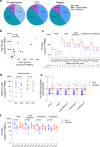This is a preprint.
Aminobisphosphonates reactivate the latent reservoir in people living with HIV-1
- PMID: 36798291
- PMCID: PMC9934553
- DOI: 10.1101/2023.02.07.527421
Aminobisphosphonates reactivate the latent reservoir in people living with HIV-1
Update in
-
Aminobisphosphonates reactivate the latent reservoir in people living with HIV-1.Front Immunol. 2023 Sep 6;14:1219250. doi: 10.3389/fimmu.2023.1219250. eCollection 2023. Front Immunol. 2023. PMID: 37744358 Free PMC article.
Abstract
Antiretroviral therapy (ART) is not curative due to the existence of cellular reservoirs of latent HIV-1 that persist during therapy. Current research efforts to cure HIV-1 infection include "shock and kill" strategies to disrupt latency using small molecules or latency-reversing agents (LRAs) to induce expression of HIV-1 enabling cytotoxic immune cells to eliminate infected cells. The modest success of current LRAs urges the field to identify novel drugs with increased clinical efficacy. Aminobisphosphonates (N-BPs) that include pamidronate, zoledronate, or alendronate, are the first-line treatment of bone-related diseases including osteoporosis and bone malignancies. Here, we show the use of N-BPs as a novel class of LRA: we found in ex vivo assays using primary cells from ART-suppressed people living with HIV-1 that N-BPs induce HIV-1 from latency to levels that are comparable to the T cell activator phytohemagglutinin (PHA). RNA sequencing and mechanistic data suggested that reactivation may occur through activation of the activator protein 1 signaling pathway. Stored samples from a prior clinical trial aimed at analyzing the effect of alendronate on bone mineral density, provided further evidence of alendronate-mediated latency reversal and activation of immune effector cells. Decay of the reservoir measured by IPDA was however not detected. Our results demonstrate the novel use of N-BPs to reverse HIV-1 latency while inducing immune effector functions. This preliminary evidence merits further investigation in a controlled clinical setting possibly in combination with therapeutic vaccination.
Conflict of interest statement
DECLARATION OF INTERESTS
The Authors declare no competing interests
Figures





References
-
- Chun T. W. et al., Quantification of latent tissue reservoirs and total body viral load in HIV-1 infection. Nature 387, 183–188 (1997). - PubMed
-
- Board N. L., Moskovljevic M., Wu F., Siliciano R. F., Siliciano J. D., Engaging innate immunity in HIV-1 cure strategies. Nat Rev Immunol 22, 499–512 (2022). - PubMed
Publication types
Grants and funding
LinkOut - more resources
Full Text Sources
Research Materials
